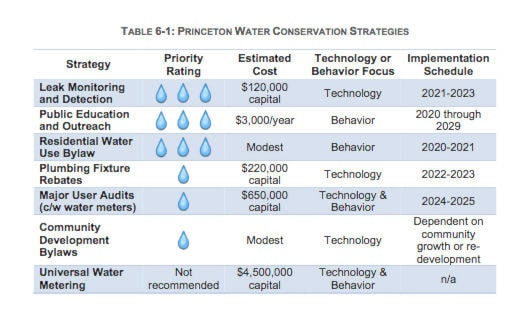If the Town of Princeton was a ship, and not a municipality, it would be in serious trouble.
That’s because it is leaking.
Princeton uses significantly more water per capita than the B.C. average, and it is suspected that much of that excess is just flowing into the ground.
The town can’t hope to come close to meeting provincial targets for water conservation in effect for 2020.
This information comes from a consultant’s Water Conservation Plan, adopted by council Monday night.
According to infrastructure director Jamie Umpleby there are many reasons for the town’s water woes, and first among them is aging infrastructure.
“Poor pipes, poor installation, corrosion, you name it,” he said. “The system is old and it needs some TLC.”
Princeton consumes 1,429 litres of water per capita per day, a number that includes industrial, commercial, seasonal usage and leakage or unaccounted for water.
The B.C. average is 494 litres.
“It’s a significant issue,” said Umpleby. “We are paying for power to pump the water and we are paying for chemicals for chlorination.”
According to the report, the town maintains and supplies 45 km of watermain to approximately 1,359 individual services, at an annual cost of approximately $400,000.
Fifty-one per cent of that infrastructure is comprised of PVC, 35 per cent is asbestos cement, while the balance is cast, ductile or galvanized iron, steel and high density polyethylene.
Councillor Randy McLean expressed frustration with the data.
“It just kills me that we are so far up there [in consumption]. What are other towns doing that we are not?”
Umpleby said it is difficult to detect leaks in the system as Princeton is primarily settled on sand and gravel.
“Leaks go down and they don’t come up…it’s hard for them to surface and they just go into the ground and disappear.”
As recommended in the conservation plan, the town has budgeted to purchase leak detection equipment at an estimated cost of $120,000.
“Once we have leak detection, once we start doing that, we will have a much better handle on it.”
He echoed the report’s findings that the problem is compounded by the fact Princeton water is not metered (with the exception of 53 units) and by personal habits.
A major contributor to winter water use is the common practice of leaving taps running in cold weather to prevent systems from freezing, he noted.
While the province has required municipalities to reduce water consumption by 33 per cent between 2008 and 2020 the report suggests Princeton will not reach that target until 2029.
The plan calls for water use reduction strategies to be implemented over the next six years including leak monitoring and detection, public education, a resident water use bylaw, plumbing fixture rebates and major user audits. Capital expenditures attached to those initiatives total an estimated $990,000.
Universal water metering was not recommended by the consultants, as it would cost $4.5 million and would result in a projected $7,000 a year savings, creating a potential payback period of 643 years.
